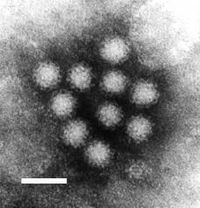
Photo from wikipedia
In COVID19 management, CT images are used as noninvasive diagnostic tools for screening and disease monitoring. Segmentation of infections provides valuable visual interpretations in the process of prognosis and decision… Click to show full abstract
In COVID19 management, CT images are used as noninvasive diagnostic tools for screening and disease monitoring. Segmentation of infections provides valuable visual interpretations in the process of prognosis and decision making. Segmentation of COVID19 infection from chest CT images is challenging due to the presence of multiple infection types and complex morphological patterns. This paper presents a novel multi task learning framework for COVID19 infection segmentation and detection. The proposed model called DB‐YNet, is built on YNet architecture with a dense bottleneck and attention based UNet backbone. This model is trained and tested with standard datasets, demonstrating superior segmentation and classification metrics. It achieves a Dice score of 0.9923 for segmentation, and classification accuracies of 0. 0.9875 and 0.9961 under binary and multi class classifications respectively. In COVID19 triage, DB‐YNet is a promising tool to assist physicians in the early identification of COVID19 infected patients for quick clinical interventions.
Journal Title: International Journal of Imaging Systems and Technology
Year Published: 2023
Link to full text (if available)
Share on Social Media: Sign Up to like & get
recommendations!